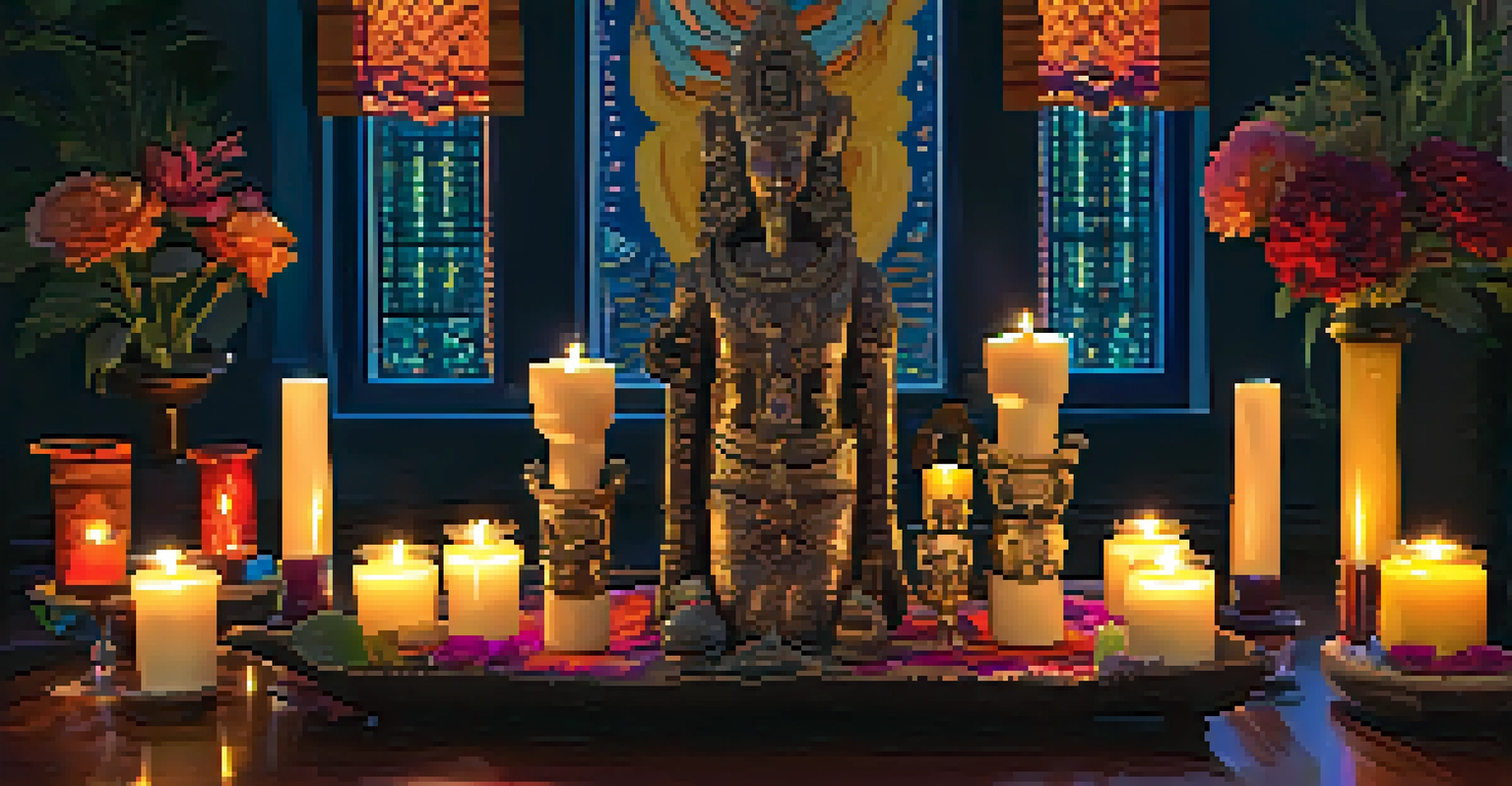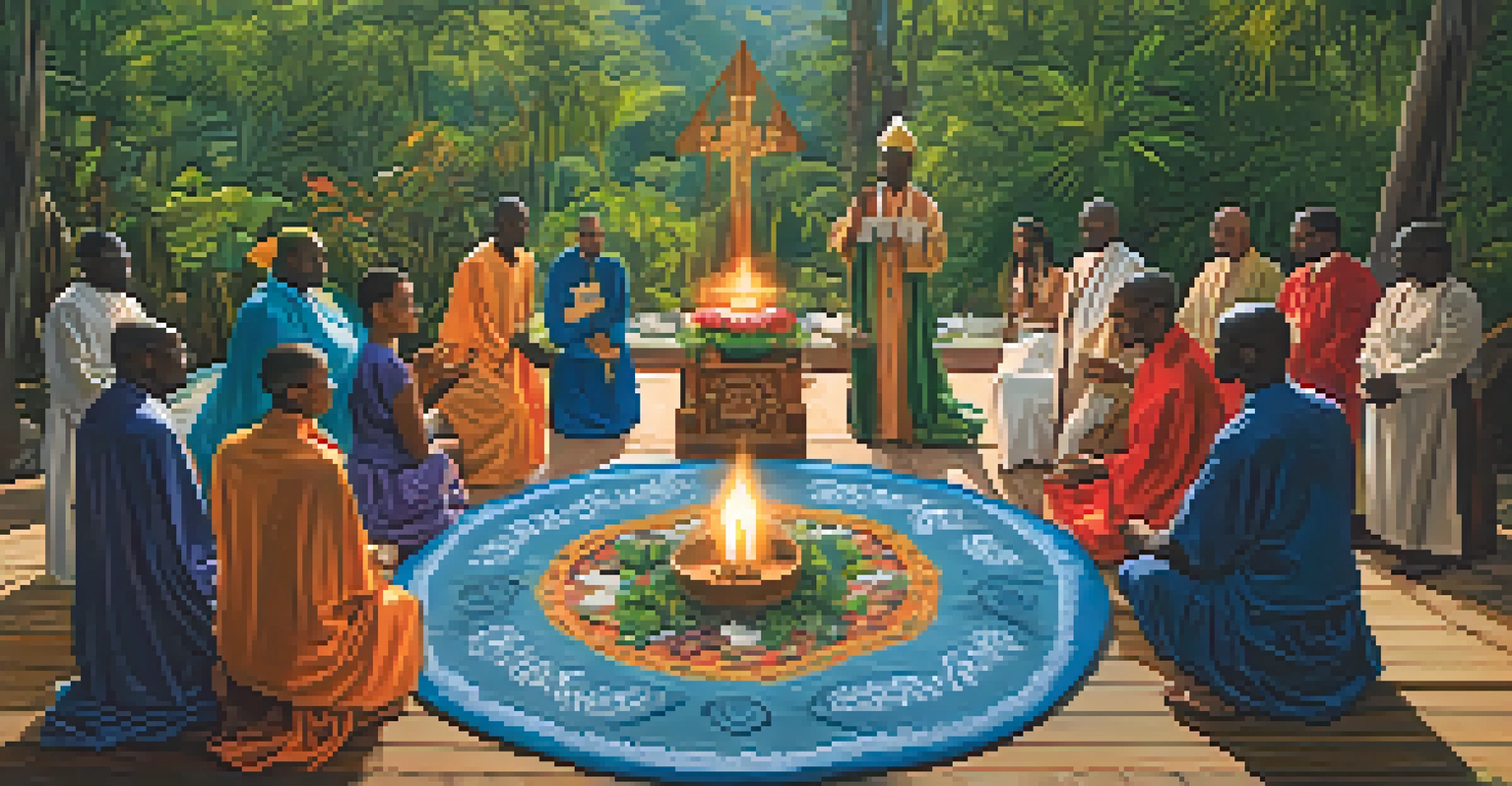The Intersection of Voodoo and Catholicism in New Orleans

Understanding Voodoo: A Spiritual Tradition in New Orleans
Voodoo, often misunderstood, is a rich spiritual tradition rooted in African, Caribbean, and indigenous beliefs. In New Orleans, it has evolved into a unique practice that reflects the city's diverse cultural heritage. Unlike the stereotypes often depicted in movies, Voodoo is not about curses or evil; rather, it focuses on community, healing, and connection to ancestors.
Voodoo is not about curses or evil; rather, it focuses on community, healing, and connection to ancestors.
At its core, Voodoo emphasizes the importance of spirits, known as 'Loa,' who serve as intermediaries between humans and the divine. Practitioners often engage in rituals that honor these spirits, seeking guidance and support in their daily lives. This connection to the spiritual realm is a fundamental aspect of Voodoo that resonates with many in New Orleans.
The vibrant celebrations, colorful altars, and lively music associated with Voodoo contribute to the city's unique atmosphere. These elements invite both locals and visitors to explore the practice's depth, revealing a culture that is as complex as it is beautiful.
The Role of Catholicism in New Orleans' Spiritual Landscape
Catholicism has a long-standing presence in New Orleans, dating back to the city's founding in 1718. The Catholic Church has shaped much of the city's culture, architecture, and festivals, creating a strong spiritual foundation for many residents. From grand cathedrals to community gatherings, Catholic rituals are woven into the fabric of New Orleans life.

Central to the Catholic faith is the veneration of saints, which mirrors some aspects of Voodoo practice. For instance, both traditions emphasize the importance of asking for intercession from spiritual beings. This shared belief creates an intriguing intersection where Catholic saints are sometimes syncretized with Voodoo Loa, demonstrating how these faiths can coexist.
Voodoo's True Nature in New Orleans
Voodoo is a community-oriented spiritual tradition focused on healing and ancestral connection, rather than the dark magic often portrayed in popular culture.
Celebrations like Mardi Gras showcase the blending of these spiritual practices, where both Voodoo and Catholic elements can be seen in the festive atmosphere. This harmonious coexistence highlights the adaptability of religious beliefs in a city known for its vibrant culture and diversity.
Syncretism: The Fusion of Voodoo and Catholic Beliefs
Syncretism, the blending of different religious beliefs, is a hallmark of New Orleans' spiritual landscape. In this city, Voodoo and Catholicism have intertwined over centuries, creating a unique spiritual practice that resonates with many. This fusion allows practitioners to draw upon the strengths of both traditions, enriching their spiritual experiences.
The future of Voodoo and Catholicism in New Orleans will depend on the community's willingness to embrace diversity and celebrate their shared history.
One example of syncretism is the way some Voodoo practitioners may invoke Catholic saints during rituals. For instance, Saint Expedite, known for swift assistance, is often called upon in Voodoo ceremonies for quick resolutions to problems. Such practices illustrate how individuals can navigate their spiritual journeys by embracing multiple faiths.
This blending is not merely a matter of convenience; it reflects a deep respect for the beliefs that shape the community. By honoring both Voodoo and Catholicism, practitioners celebrate the rich tapestry of cultural and spiritual influences that define New Orleans.
Rituals: How Voodoo and Catholic Practices Intertwine
Rituals play a vital role in both Voodoo and Catholic traditions, serving as a means to connect with the divine. In Voodoo, rituals may involve offerings, songs, and dances to honor the Loa, while Catholic rituals often include prayer, sacraments, and the celebration of Mass. The shared focus on ritual underscores the importance of these practices in fostering spiritual connections.
During significant life events, such as births, weddings, and funerals, elements from both traditions may be incorporated. For example, a Voodoo ceremony might take place alongside a Catholic mass, blending prayers and offerings to create a comprehensive spiritual experience. This integration allows individuals to honor their heritage while embracing their faith.
Syncretism of Voodoo and Catholicism
The blending of Voodoo and Catholic practices in New Orleans reflects a rich cultural tapestry, allowing practitioners to draw strength from both spiritual traditions.
The blending of rituals not only reflects personal beliefs but also fosters community ties. In New Orleans, families often gather to celebrate both Voodoo and Catholic traditions, creating a rich tapestry of spiritual expression that strengthens their cultural identity.
The Influence of New Orleans' Culture on Spiritual Practices
New Orleans is a city renowned for its music, food, and festivals, all of which play a significant role in shaping its spiritual practices. The sounds of jazz and blues, for example, are often intertwined with spiritual themes, creating an atmosphere where Voodoo and Catholicism can flourish. This cultural vibrancy enriches the spiritual landscape, making it a living expression of the city's unique identity.
Festivals like Mardi Gras serve as a canvas for this cultural and spiritual fusion. Participants often don costumes that reflect both Catholic saints and Voodoo spirits, celebrating the interconnectedness of these traditions. This celebration not only honors the city's diverse heritage but also invites people from various backgrounds to join in the festivities.
As a result, New Orleans becomes a microcosm of cultural exchange, where traditions are not just preserved but celebrated and adapted. This dynamic environment allows both Voodoo and Catholicism to thrive, showcasing the city's ability to embrace complexity and diversity in its spiritual practices.
Contemporary Voodoo: Misconceptions and Realities
Despite its deep roots in New Orleans, contemporary Voodoo often faces misconceptions and stereotypes. Many people associate Voodoo with dark magic or witchcraft, overlooking its true essence as a community-oriented spiritual practice. This misunderstanding can lead to a lack of appreciation for the rich traditions and customs that define Voodoo today.
In reality, contemporary Voodoo emphasizes healing, connection, and social justice. Many practitioners engage in community service, using their spiritual beliefs to address social issues and promote well-being. This modern interpretation reflects a commitment to uplifting the community while honoring ancestral traditions.
Future of Spiritual Practices
As New Orleans evolves, the relationship between Voodoo and Catholicism continues to adapt, with younger generations embracing and blending both traditions.
Education and outreach play a crucial role in dispelling myths surrounding Voodoo. By sharing their stories and practices, contemporary practitioners are helping to reshape the narrative around Voodoo, inviting others to understand its significance and complexity.
The Future of Voodoo and Catholicism in New Orleans
As New Orleans continues to evolve, so too does the relationship between Voodoo and Catholicism. The city's increasing diversity brings new cultural influences that can further enrich this spiritual landscape. This ongoing evolution presents an opportunity for both traditions to adapt and thrive in a changing world.
Younger generations are increasingly engaging with their spiritual heritage, often blending elements of both Voodoo and Catholicism in their practices. This intergenerational exchange fosters a deeper appreciation for the complexities of their beliefs, ensuring that both traditions remain relevant in contemporary society.

Ultimately, the future of Voodoo and Catholicism in New Orleans will depend on the community's willingness to embrace diversity and celebrate their shared history. By honoring their past while looking toward a vibrant future, the people of New Orleans can continue to create a unique spiritual tapestry that reflects their rich cultural heritage.